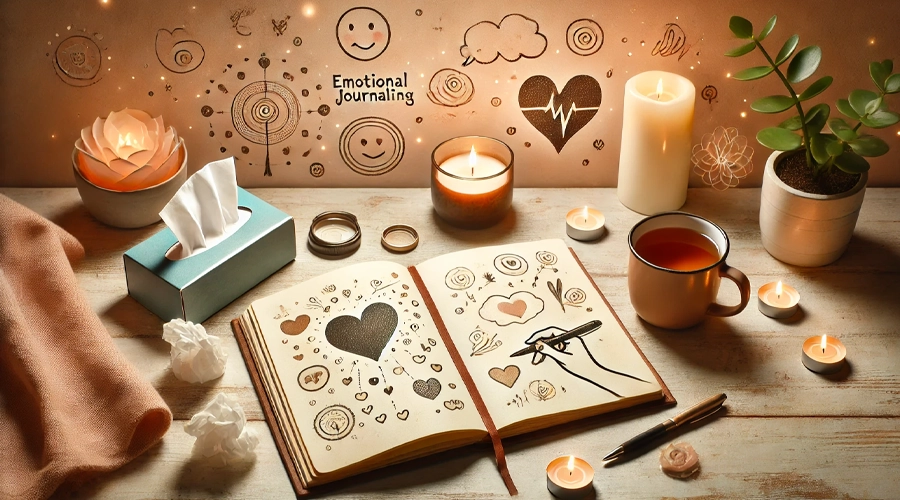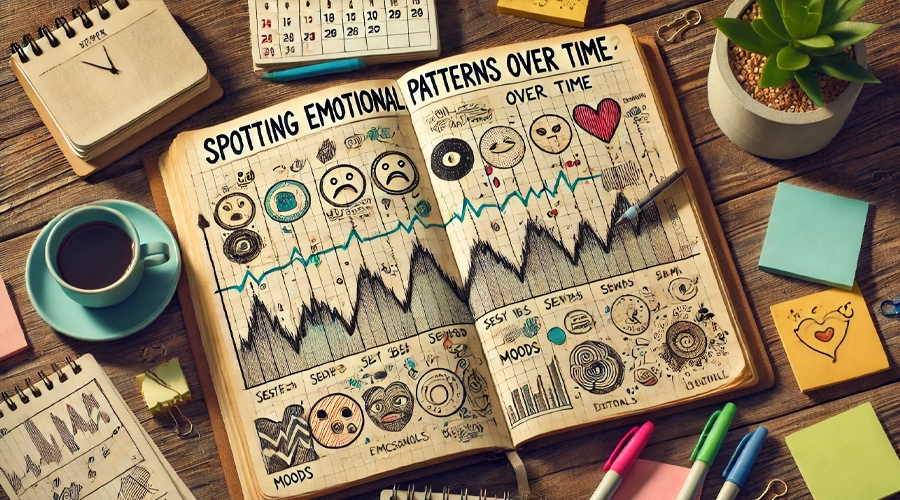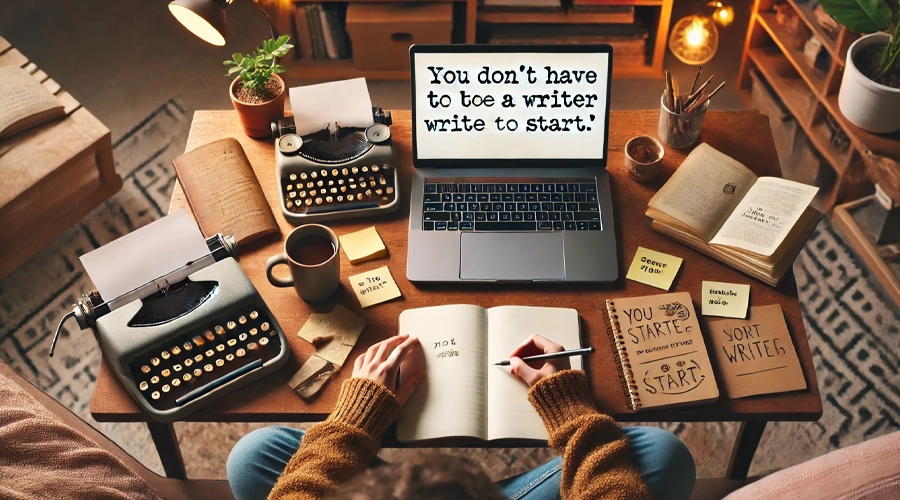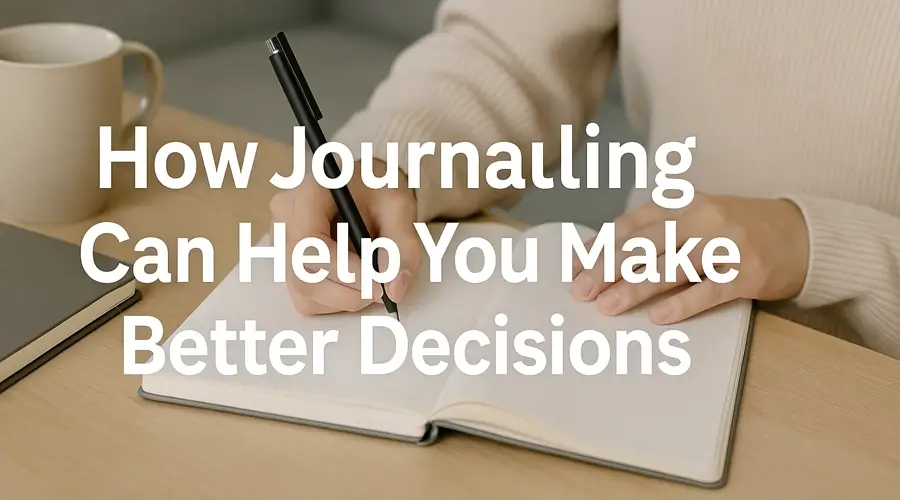In a world that moves at the speed of notifications, it’s easy to lose track of what we actually feel. We rush from one task to the next, scrolling through curated lives, reacting to messages, deadlines, and distractions. Somewhere in that chaos, our emotions get muted—still present, but buried under noise.
This emotional disconnect isn’t rare. In fact, it’s becoming the norm. We’ve learned to function while suppressing what we feel: to smile when we’re anxious, to keep quiet when we’re overwhelmed, and to power through even when something inside us is begging for attention. The truth? Most of us were never really taught how to sit with our emotions—let alone understand them.
That’s where emotional journaling comes in.
Not as another item on your to-do list, but as a quiet rebellion against emotional numbness. Emotional journaling is the practice of writing honestly about your inner world. It’s where thoughts meet feelings on the page—without filters, without judgment. It doesn’t require you to fix anything. It simply invites you to feel and notice, one word at a time.
In this article, we’ll explore how this simple yet powerful habit can help you reconnect with your emotions, gain clarity, and develop a deeper understanding of yourself—even in a world that constantly pulls you away from it.
What Is Emotional Journaling, Really?
Let’s get one thing out of the way: emotional journaling is not about scribbling “Dear Diary” confessions with a pink pen under your pillow. Forget the clichés. This isn’t about dramatizing your life—it’s about understanding it.
At its core, emotional journaling is the intentional act of writing down your thoughts, feelings, and internal experiences with honesty and awareness. It’s a space where you pause the noise of the outside world and tune into what’s really going on inside. Not to judge. Not to solve. Just to witness.
Unlike gratitude journals that focus on the positive, or bullet journals that organize tasks and goals, emotional journaling digs deeper. It’s not structured or aesthetic-driven. It’s raw, unfiltered, and personal. It’s less about what happened during your day—and more about how it made you feel.
You’re not writing to perform. You’re writing to process.
That’s what makes emotional journaling so powerful. It becomes a mirror to your inner world—a tool that helps you notice patterns, name emotions, and develop emotional clarity over time. It’s not just writing. It’s self-connection through ink.
Emotional Awareness Starts with the Page
Most of us were raised to manage our emotions, not to understand them. We were told to “stay strong,” “move on,” or “get over it”—so we learned to suppress rather than reflect. But the truth is, what we ignore doesn’t disappear. It lingers. It builds up. And eventually, it speaks—often through stress, anxiety, or burnout.
Emotional journaling offers a gentle alternative. Instead of pushing feelings aside, it invites you to meet them on the page. Writing gives shape to what’s been swirling inside your head. It slows down the mental chaos and helps you look at your emotions from a safer distance—almost like watching a storm from behind a window, rather than being caught in the rain.
By journaling regularly, you begin to spot emotional patterns you might otherwise miss. Maybe anger shows up every time you feel unheard. Maybe anxiety creeps in when you face change. These connections—subtle, yet powerful—can only surface when you pause and reflect.
That’s the quiet magic of emotional journaling: it turns the invisible into something you can see, something you can work with. Words become a bridge between your inner world and conscious awareness. They help untangle emotional confusion and transform it into understanding.
Because sometimes, writing it down is the first step to truly feeling it through.

Facing, Not Fixing: Why Journaling Feels Emotionally Safe
In a world obsessed with quick fixes, we’ve learned to treat emotions like problems to solve. Feeling anxious? Meditate it away. Feeling sad? Scroll it away. But emotions aren’t errors in your system—they’re signals. They’re meant to be heard, not silenced.
That’s where emotional journaling becomes something radically different. It doesn’t ask you to fix how you feel. It simply offers you a space where you can face it—all of it—without judgment, filters, or pressure.
Journaling is a judgment-free zone. You don’t need to justify your sadness or water down your anger. You don’t have to be polite on the page. This space is yours—raw, messy, and honest. And that honesty is what makes it healing.
Through emotional journaling, you begin to understand the concept of emotional processing—the slow, intentional act of sitting with your feelings rather than pushing them away. It’s about letting your emotions move through you instead of bottling them up. And that’s where self-compassion starts: in giving yourself permission to feel without shame.
When you write, you’re not performing. You’re witnessing.
Over time, this creates an emotional space where clarity can grow and healing can begin. You don’t need to have the answers—you just need the courage to show up for yourself on the page.
When and How to Journal for Emotional Clarity
There’s no one perfect way to start emotional journaling, and that’s the beauty of it. You don’t need an hour of free time or a fancy leather-bound notebook. You just need a few minutes—and a willingness to show up for yourself honestly.
Simple strategies that work in real life
Start small. Even five minutes of focused writing can shift your perspective. Choose a time when you’re least distracted—maybe before bed or first thing in the morning. The key isn’t consistency in schedule, but consistency in showing up when it matters. You’re not journaling to be productive. You’re journaling to be present.
Recommended tools: digital apps vs. physical notebooks
Whether you use a notes app, voice memos, or a classic pen and paper, pick what feels natural to you. Some people love the tactile feel of writing by hand—it slows them down and helps them connect. Others prefer typing, especially if thoughts come fast. Tools like Day One, Journey, or even Google Docs can serve as your emotional archive. The best tool is the one you’ll actually use.
Examples of mindful journaling prompts for emotional insight
If you’re feeling stuck or unsure where to begin, prompts can open the door. Here are a few powerful ones to get you started with your emotional journaling practice:
-
What am I feeling right now, and where do I feel it in my body?
-
What triggered this emotion? What might be underneath it?
-
What do I need to hear right now—from myself?
-
If my emotion had a voice, what would it say?
-
What would I write if no one was ever going to read this?
These aren’t just questions. They’re gentle nudges toward deeper emotional awareness.
Emotional journaling doesn’t require perfection. It requires presence. And with time, those short daily entries can become one of the most honest conversations you’ve ever had—with yourself.
Breaking the Loop: Spotting Emotional Patterns Over Time
One of the most powerful (and underrated) benefits of emotional journaling is its ability to reveal the emotional loops we unknowingly live in. When you journal consistently, even if it’s just a few lines a day, you begin to notice the echoes—those same feelings, same thoughts, same reactions showing up again and again.
It’s not about overanalyzing every emotion. It’s about recognizing patterns that were once invisible. Maybe every Sunday night, your anxiety spikes. Maybe certain people, situations, or words always stir up anger or shame. These are your emotional triggers—the subtle sparks that ignite a deeper emotional fire.

And the more you journal, the more you’ll see how your mind and body respond—often unconsciously—to those triggers. This awareness gives you something you didn’t have before: choice. The choice to pause, breathe, and respond rather than react.
Real-world example: a transformation through journaling
Take Maya, for example. She started emotional journaling to cope with stress at work. After a month, she noticed a pattern: her most intense frustration didn’t happen during meetings or deadlines—it happened after phone calls with her manager. Through journaling, she realized those conversations triggered an old wound of not feeling “good enough.” That insight alone changed how she approached feedback, her self-talk, and eventually, her confidence.
What Science Says: Journaling and Emotional Well-Being
While emotional journaling often feels deeply personal and intuitive, its benefits are strongly backed by research. Science agrees: putting pen to paper (or fingers to keyboard) isn’t just cathartic—it’s transformative.
Evidence-based benefits of emotional journaling
Studies have shown that emotional journaling can improve mental health by increasing self-awareness, enhancing mood, and even boosting immune function. According to research by Dr. James Pennebaker, a pioneer in expressive writing, people who journal about their emotions regularly experience fewer doctor visits, improved memory, and a greater sense of psychological resilience.
Why? Because writing helps you process emotional experiences in a structured way, reducing the brain’s need to “hold onto” stress.
Reducing stress, anxiety, and emotional overwhelm
In the rush of daily life, emotions often build up without an outlet—leading to emotional overwhelm. Emotional journaling creates that much-needed release valve. It gives you space to slow down, observe what you’re feeling, and offload it safely.
Multiple studies have linked regular journaling with reduced symptoms of anxiety and depression. The simple act of naming your feelings and exploring them in writing can calm the nervous system and reduce cortisol levels—the stress hormone that fuels tension.
The link between journaling and emotional regulation
When you journal consistently, you begin to develop better emotional regulation—the ability to respond to emotions with awareness rather than impulse. Instead of reacting out of habit, you learn to pause, reflect, and choose your next step.
In short, emotional journaling rewires the way you relate to your inner world. It turns your journal into a safe space for reflection, growth, and healing—one entry at a time.
You Don’t Have to Be a Writer to Start
Let’s get this straight: emotional journaling isn’t about writing beautifully. It’s not about grammar, punctuation, or poetic language. It’s about being real—and that’s something everyone can do.

Ditching perfection: Journaling for real people
You don’t need to be a writer. You don’t need to be eloquent. You just need to be honest. Perfection is not the goal—presence is. If your sentences are messy, half-finished, or don’t make sense, that’s okay. You’re not submitting an essay. You’re showing up for yourself.
Quick entries, drawings, or messy pages—everything counts
Emotional journaling can take any form. It might be a single sentence: “I feel off today and I don’t know why.” It might be a full page of emotional ranting. It might even be a doodle or a mind map when words don’t come easily. However it flows out of you, it counts. Every expression is valid.
Journaling without pressure or performance
There’s no right way to do this. Some days you’ll write pages. Other days, just a word or two. That’s the beauty of emotional journaling—it meets you where you are. No pressure to be profound. No need to impress. Just space to be you.
Conclusion: Make Friends with Your Emotions
You don’t need to have it all figured out. You don’t need to wait until you feel “ready.” The truth is, understanding your emotions doesn’t start with answers—it starts with attention. And emotional journaling is one of the most powerful, accessible ways to give yourself that attention.
So here’s your invitation: open a page, take a breath, and write one honest sentence. That’s all it takes. You might be surprised at what comes next.
Because emotional growth doesn’t require perfection—it requires presence. And the more you practice showing up for yourself on the page, the more you’ll realize: your emotions aren’t something to fix or fear. They’re something to befriend.
Let emotional journaling be that quiet space where you reconnect with your inner world, one messy, meaningful word at a time.
✨ Ready to Turn Thoughts into Clarity?
Start your emotional journaling journey with VERVOAI — your AI-powered companion for honest self-reflection. No pressure. No judgment. Just you, your emotions, and a space that gets you.
👉 Download VERVOAI now and let your inner voice speak. One entry at a time.



